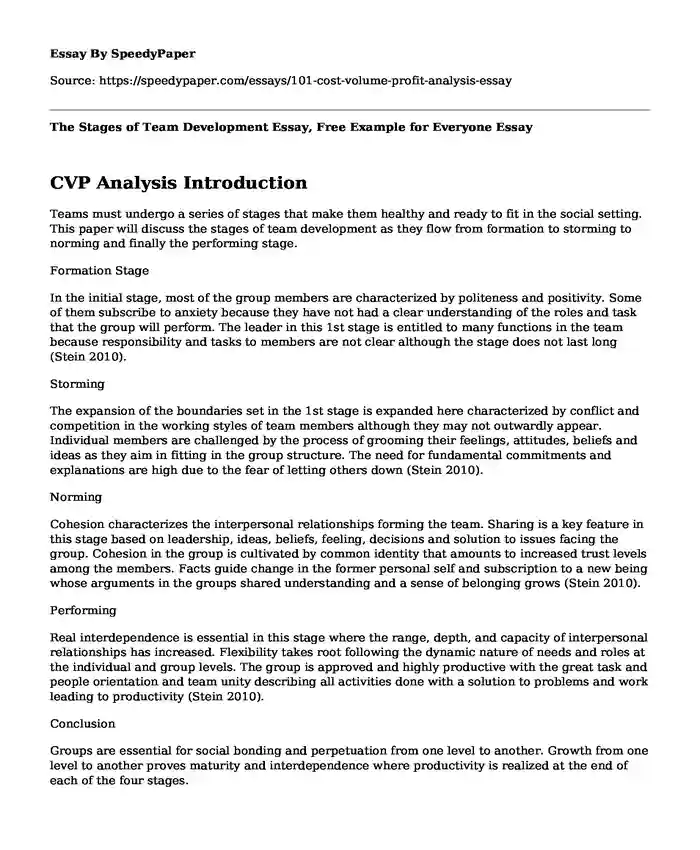
| Type of paper: | Essay |
| Categories: | Leadership analysis Human resources |
| Pages: | 2 |
| Wordcount: | 402 words |
CVP Analysis Introduction
Teams must undergo a series of stages that make them healthy and ready to fit in the social setting. This paper will discuss the stages of team development as they flow from formation to storming to norming and finally the performing stage.
Formation Stage
In the initial stage, most of the group members are characterized by politeness and positivity. Some of them subscribe to anxiety because they have not had a clear understanding of the roles and task that the group will perform. The leader in this 1st stage is entitled to many functions in the team because responsibility and tasks to members are not clear although the stage does not last long (Stein 2010).
Storming
The expansion of the boundaries set in the 1st stage is expanded here characterized by conflict and competition in the working styles of team members although they may not outwardly appear. Individual members are challenged by the process of grooming their feelings, attitudes, beliefs and ideas as they aim in fitting in the group structure. The need for fundamental commitments and explanations are high due to the fear of letting others down (Stein 2010).
Norming
Cohesion characterizes the interpersonal relationships forming the team. Sharing is a key feature in this stage based on leadership, ideas, beliefs, feeling, decisions and solution to issues facing the group. Cohesion in the group is cultivated by common identity that amounts to increased trust levels among the members. Facts guide change in the former personal self and subscription to a new being whose arguments in the groups shared understanding and a sense of belonging grows (Stein 2010).
Performing
Real interdependence is essential in this stage where the range, depth, and capacity of interpersonal relationships has increased. Flexibility takes root following the dynamic nature of needs and roles at the individual and group levels. The group is approved and highly productive with the great task and people orientation and team unity describing all activities done with a solution to problems and work leading to productivity (Stein 2010).
Conclusion
Groups are essential for social bonding and perpetuation from one level to another. Growth from one level to another proves maturity and interdependence where productivity is realized at the end of each of the four stages.
Reference
Stein J., 2010. Learning & Development: Using the Stages of Team Development. Retrieved from http://hrweb.mit.edu/learning-development/learning-topics/teams/articles/stages-development
Cite this page
The Stages of Team Development Essay, Free Example for Everyone. (2018, Jun 27). Retrieved from https://speedypaper.net/essays/101-cost-volume-profit-analysis-essay
Request Removal
If you are the original author of this essay and no longer wish to have it published on the SpeedyPaper website, please click below to request its removal:
- Work 88 by Martin Creed - Essay Example in Art
- Book Review Essay Sample on My Sister's Keeper
- Essay Sample about the Flight Centre Travel Group 2017 Annual Report
- Essay Sample Dedicated to Employment and Labor Relations
- Essay Sample on Certification and Tools in the Agile Scrum Environment
- Essay Sample: Good Communication Skills and Knowledge Aid in Solving Problems
- Details Amount Details Amount
Popular categories




